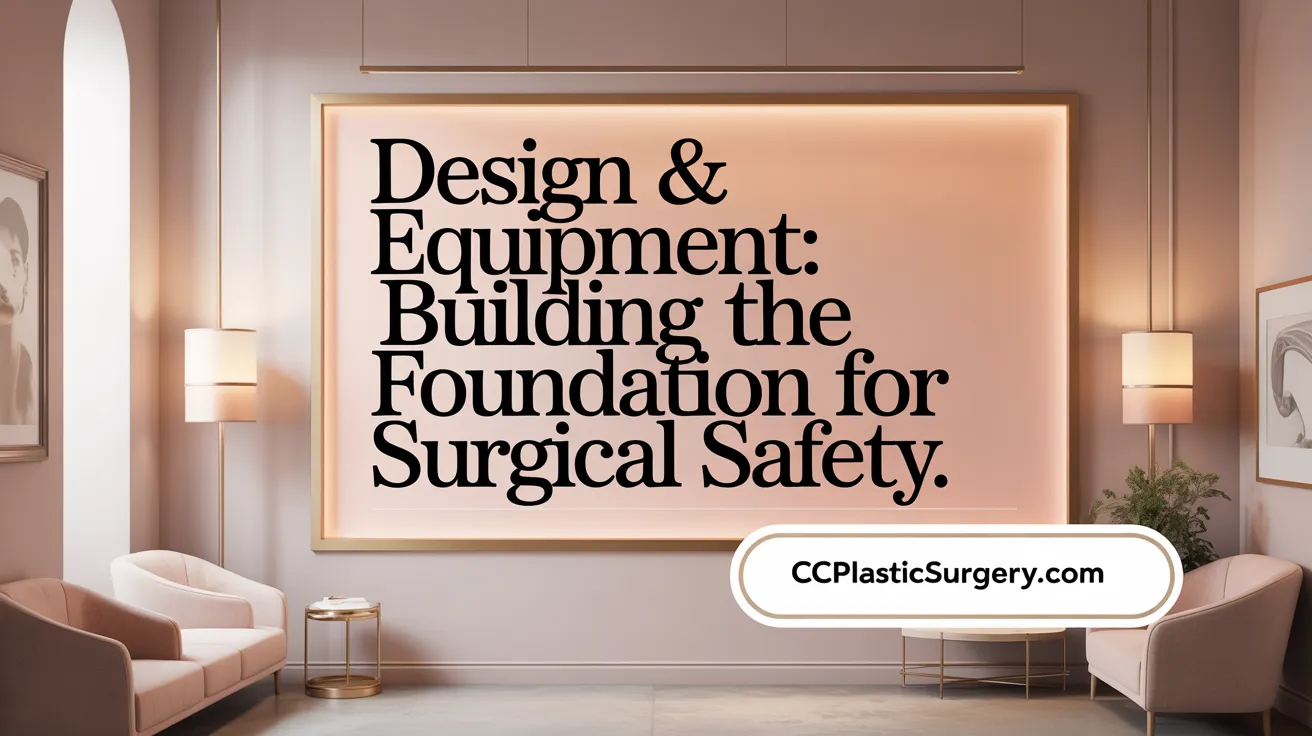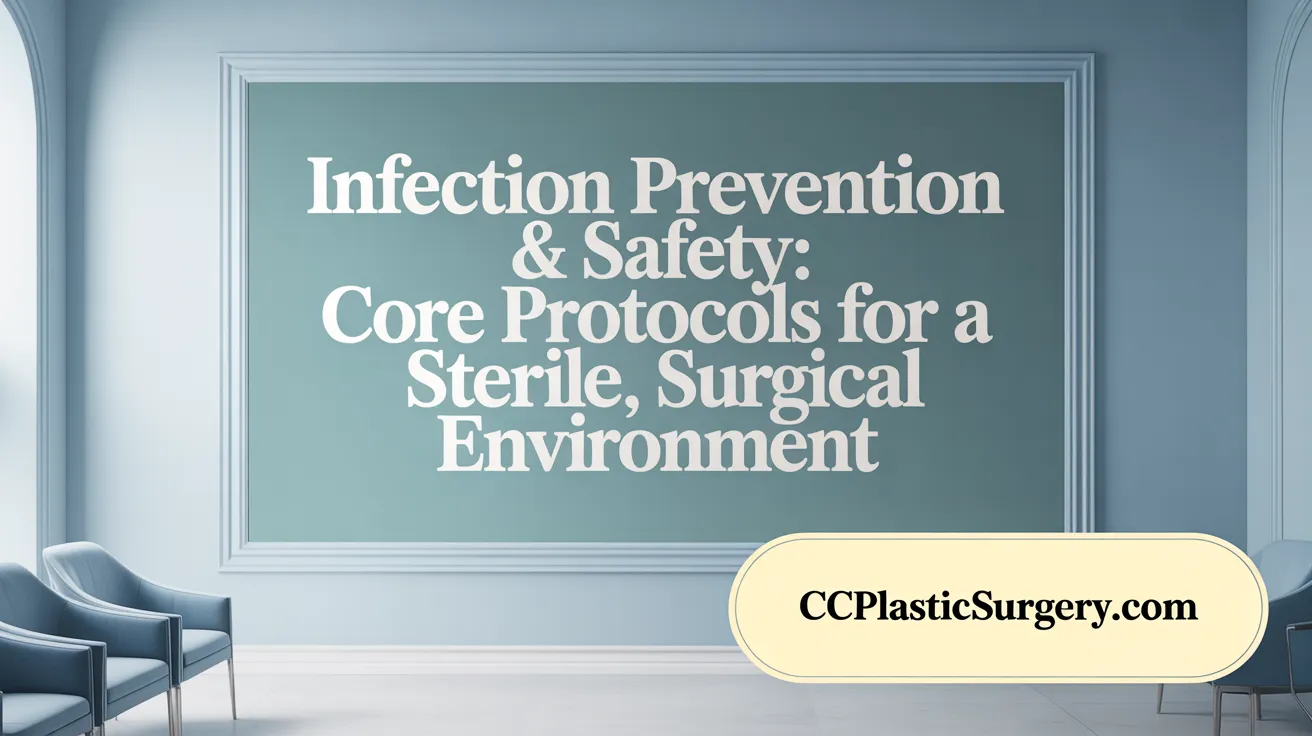
December 16, 2025
Explore coolsculpting chin fat: A guide to sharper definition
Want to tackle coolsculpting chin fat? This guide explains the procedure, pricing, downtime, and expected results to help you decide on a sharper jawline.
Oct 23, 2025

In the realm of surgical care, patient safety and facility accreditation are paramount. Accredited surgical suites operate under rigorous standards designed to guarantee the highest level of care, encompassing staff qualifications, equipment reliability, sanitation, emergency preparedness, and infection control. Understanding what goes on behind the scenes in these on-site surgical suites reveals the extensive measures taken to protect patients and staff alike.
Accreditation serves as a hallmark of safety and quality for surgical facilities. It confirms that a facility complies with rigorous standards designed to protect patient well-being. These standards cover critical areas such as staff qualifications, sanitation protocols, emergency preparedness, and the upkeep of medical equipment. Choosing an accredited surgical facility means entrusting your care to an environment that consistently meets hospital-level safety and cleanliness benchmarks. Regular inspections and thorough documentation ensure ongoing adherence to these standards.
Several major national bodies provide accreditation for surgical facilities, each emphasizing safety, quality, and compliance. These include:
Each accreditor conducts regular onsite surveys and reviews facility processes to ensure continuous compliance. For more details on accrediting organizations and facility requirements, see Major Surgical Accrediting Bodies.
Accreditation standards typically address:
Facilities must demonstrate ongoing quality assurance programs and maintain accurate medical records. Comprehensive standards and guidelines are detailed in Facility Safety and Quality Standards and Standard Precautions in Patient Care.
Accrediting agencies conduct thorough, often unannounced, onsite evaluations. These assessments include observation of surgical procedures, review of policies, staff interviews, and verification of equipment functionality. Facilities are required to address deficiencies through corrective action plans. Continuous inspections and audits promote sustained compliance and patient safety. The inspection process is described in detail through resources such as Regular Accreditation Inspections and ASC accreditation application process.
Surgeons are mandated to perform surgeries exclusively in accredited facilities to gain or maintain board certification, such as by the American Board of Cosmetic Surgery (ABCS). They must provide documentation of operating privileges at accredited hospitals or outpatient centers. This ensures that surgeons practice within environments that uphold safety and quality standards, reaffirming the commitment to professional ethics and patient care excellence. Additional surgeon credentialing requirements can be found under Surgeon Operating Privileges.

A surgical suite overview encompasses one or more operating rooms paired with essential adjunct areas including sterile storage in surgical suites, scrub rooms in hospitals, and recovery rooms in surgical suites. These components are strategically designed to support a sterile environment and efficient workflow crucial for patient safety during surgical procedures.
Operating rooms must be equipped with vital pieces of equipment such as a call-in system in operating rooms, cardiac monitors in OR suites to continuously observe patient's heart activity, resuscitators for operating rooms and defibrillators in OR suites for emergency cardiac support, aspirators in operating rooms for clearing airways, and tracheotomy sets availability. These devices must be regularly maintained and verified operational according to hospital standards and accreditation requirements to ensure reliability.
Surgical suite design is fundamental in promoting a safe environment. Air quality is enhanced by utilizing technologies like high-efficiency particulate air (HEPA) filters and ultraclean laminar airflow systems, which substantially reduce the risk of surgical site contamination. The layout is carefully planned to provide ample space—usually about four feet around the sterile field—to facilitate smooth movement of personnel and equipment and to enable swift emergency responses when necessary. Additionally, specialized tools such as smoke evacuation systems are integrated to minimize staff and patient exposure to toxic surgical smoke, enhancing overall safety.
Innovations like minimally invasive surgical tools, robotics, and imaging technology in surgery demand specialized suite designs accommodating advanced equipment. Integration of information systems bolsters operational efficiency and patient monitoring, while ergonomic designs reduce staff injury risks. These technologies, though potentially costly, play a crucial role in elevating surgical precision and safety.
Strict adherence to cleaning and sterilization routines—ranging from pre-case to terminal cleaning—helps prevent infections (cleaning and disinfection standards). Verification processes prevent errors such as retained surgical items, supported by advanced detection systems. Proper patient positioning, optimal lighting, and protocols aligned with regulatory standards further secure the environment. Staff training in emergency preparedness and sterile techniques reinforces a culture of safety (safety standards in surgical facilities).
| Aspect | Details | Importance |
|---|---|---|
| Surgical Suite | Operating rooms + sterile storage, scrub, recovery (Surgical suite overview) | Ensures controlled, sterile workflow |
| Mandatory Equipment | Call-in system, monitors, resuscitator, defibrillator, aspirator, tracheotomy set (Operating room equipment availability) | Supports readiness for emergencies |
| Air Quality | HEPA filters, laminar airflow (Safety in the Operating Room) | Reduces contamination and infection risk |
| Design Layout | Adequate sterile field space, emergency access | Facilitates movement, safety compliance |
| Technologies | Smoke evacuation, minimally invasive tools, robotics (Safety in the Operating Room | Enhances safety and precision |
| Safety Protocols | Cleaning, sterilization, verification, training (Patient Safety in Accredited Outpatient Facilities) | Minimizes errors and infection |

Standard Precautions form the backbone of infection prevention in surgical environments. These include stringent hand hygiene practices, the use of personal protective equipment (PPE) such as gloves, gowns, and masks, and appropriate patient placement to reduce the spread of infectious agents. Moreover, adherence to safe injection practices and meticulous cleaning and disinfection of surgical equipment and the environment are essential. These measures ensure the control of microbial transmission, protecting both patients and healthcare workers from infections.
Surgical smoke, a toxic byproduct of many procedures, is managed effectively through specialized filtration systems such as the STERIS Smoke Evacuation System, which captures and filters harmful particles to reduce exposure. Beyond smoke, surgical suites face hazards from waste anesthetic gases, biological agents, compressed gases, and ionizing radiation. Compliance with OSHA protocols helps facilities monitor and mitigate these risks, maintaining a safer environment through engineering controls and staff training.
Protecting surgical personnel involves a comprehensive approach to occupational safety. Facilities implement ergonomic interventions to minimize physical strain and prevent musculoskeletal injuries. Adequate staffing levels and specialized staff training programs enhance safety awareness and readiness. The use of PPE is mandated to shield workers from infectious and chemical exposures. Safety programs also address workplace violence and injuries with reporting systems and preventative measures, all guided by OSHA’s recommendations to promote a culture of health and safety within surgical suites.

Accredited surgical facilities take comprehensive measures to prepare for emergencies. They maintain fully stocked emergency kits and have resuscitation equipment such as defibrillators, cardiac monitors, and aspirators readily available within the operating rooms. Emergency power supplies ensure critical systems remain operational during outages. Staff are trained extensively in safety protocols, including certifications in Basic Life Support (BLS) and Advanced Cardiovascular Life Support (ACLS). These precautions enable the team to respond effectively to patient complications or unexpected equipment failures.
Quality assurance is integral to maintaining high surgical safety standards. Facilities conduct ongoing peer reviews and analyze case data to monitor complications and mortalities. An investigative committee evaluates these outcomes to identify trends or areas needing improvement. This continuous cycle of assessment supports compliance with accreditation standards and helps uphold patient safety by ensuring all practices meet established benchmarks.
Compliance is secured through regular inspections and audits by accrediting bodies and regulatory agencies. Detailed medical records and operative reports are meticulously maintained to document procedures and assessments. Facilities must adhere to local, state, and federal regulations, including Occupational Safety and Health Administration (OSHA) guidelines and fire safety codes. They also protect patient privacy in accordance with HIPAA standards. Should a facility fail to meet these rigorous standards, it risks losing accreditation, thus motivating consistent adherence to safety requirements.

Accreditation plays a critical role in enhancing the overall safety and quality of surgical care. Facilities that achieve accreditation demonstrate reliability in performance and show a tangible commitment to minimizing risks. This not only assures patients that they are receiving care in a facility dedicated to high Facility Safety and Quality Standards but also supports compliance with federal and state regulations. Additionally, accredited centers often gain recognition from insurers and third-party payers, providing a competitive edge and fostering trust within the healthcare community. Continuous improvement culture is encouraged as facilities routinely update policies and refine procedures based on accreditation feedback.
The evaluation process typically involves thorough, unannounced on-site surveys conducted by experienced healthcare professionals. For example, The Joint Commission performs detailed assessments every three years that include direct observation of at least two surgical procedures. These surveys focus on numerous domains such as staff competency, medication management, infection control, and patient care processes. The comprehensive review ensures that accredited facilities meet strict standards and maintain consistent adherence to safety protocols, sanitation, equipment maintenance, and emergency preparedness.
Ongoing education and staff competency are cornerstones of maintaining accreditation standards and ensuring patient safety. Accrediting bodies provide a range of resources including detailed standards manuals, instructional webinars, and practical toolkits aimed at continuous learning. These educational initiatives ensure that medical personnel remain proficient in the latest surgical techniques, proper use of equipment, infection prevention, and emergency response procedures. Well-trained staff are essential to fostering a safety-oriented environment where patient outcomes are optimized and risks are minimized.
As surgical technologies advance and patient safety standards evolve, accreditation organizations are adapting to incorporate more comprehensive and specialized requirements. This includes integrating evidence-based design elements in surgical suites, such as improved air filtration and ergonomic safety measures. Enhanced data monitoring and performance metrics are becoming central to continuous quality improvement. Furthermore, accreditation processes increasingly emphasize cybersecurity for information systems and incorporate patient safety goals from the National Patient Safety Goals that streamline procedures to minimize errors. These trends reflect a shift toward dynamic accreditation models that support innovation while upholding rigorous safety standards.
The rigorous standards and continuous oversight enforced through surgical facility accreditation ensure that on-site surgical suites operate at the highest levels of safety and quality. From the specialized design of surgical environments to comprehensive infection control, emergency preparedness, and ongoing staff education, every aspect is meticulously managed. This commitment not only protects patients and surgical teams but also reinforces trust in modern surgical care, making accreditation a cornerstone of excellence in the healthcare landscape.

December 16, 2025
Want to tackle coolsculpting chin fat? This guide explains the procedure, pricing, downtime, and expected results to help you decide on a sharper jawline.

December 16, 2025
Ensuring Patient Safety Through Rigorous Accreditation on Cape Cod

December 15, 2025
Considering a subtle enhancement? Learn what is lip flip botox, how it differs from fillers, the costs involved, and what the procedure is really like.